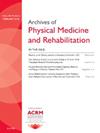学习探索和探索学习:理解残疾幼儿的动力移动使用
IF 3.6
2区 医学
Q1 REHABILITATION
Archives of physical medicine and rehabilitation
Pub Date : 2025-05-01
DOI:10.1016/j.apmr.2025.03.024
引用次数: 0
摘要
对于残疾幼儿来说,动力移动技术可以成为一种强大的工具,促进他们在家庭、社区和临床环境中进行自我探索和社会参与。然而,尽管有大量证据表明,获得独立行动能力对早期发育至关重要,但残疾幼儿获得动力行动能力的机会却非常有限。最近,Permobil Explorer Mini等新设备为处于适当发育阶段的残疾儿童提供动力移动选择变得更容易、更安全。然而,围绕幼儿如何学习使用这些设备,动力移动如何支持发展,以及我们应该如何设计动力移动干预措施,仍然存在许多悬而未决的问题。我们由工程师、临床科学家和康复专家组成的跨学科团队调查了残疾幼儿如何在实验室、家庭和诊所等一系列环境中使用动力移动进行自主游戏和康复。我们将讨论最近对超过35名不同发育障碍儿童进行的Explorer Mini实验的定量和定性结果,包括设备使用模式、发育结果以及护理人员和康复专业人员的看法。我们发现,在家中使用动力移动16周后,贝利IV在所有领域都有显着改善。在实验室里,我们证明了孩子们在15分钟的游戏中平均移动了52米的距离。这些结果支持了我们的长期目标,即建立必要的科学基础,以促进对残疾婴幼儿有临床影响的行动技术的转化。本文章由计算机程序翻译,如有差异,请以英文原文为准。
Learning to Explore and Exploring to Learn: Understanding Powered Mobility Use in Toddlers with Disabilities
For toddlers with disabilities, powered mobility technology can be a powerful tool to facilitate self-initiated exploration and social engagement in home, community, and clinical environments. However, despite overwhelming evidence that access to independent mobility is critical for early development, access to powered mobility for toddlers with disabilities is significantly limited. New devices, such as the Permobil Explorer Mini, have recently made it easier and safer to provide powered mobility options for young children with disabilities at appropriate developmental stages. Yet, many open questions remain surrounding how toddlers learn to use these devices, how powered mobility can support development, and how we should design powered mobility interventions. Our transdisciplinary team of engineers, clinician scientists, and rehabilitation professionals has investigated how toddlers with disabilities use powered mobility for self-directed play and rehabilitation across a spectrum of environments: in the lab, at home, and in the clinic. We will discuss quantitative and qualitative results from our recent Explorer Mini experiments with over 35 children with diverse developmental disabilities, including device use patterns, developmental outcomes, and the perceptions of caregivers and rehabilitation professionals. We found that after 16 weeks of using powered mobility at home, there were significant improvements in the Bayley IV across all domains. In the lab, we demonstrated that on average, kids move a distance of 52 meters in a 15-minute play session. These results support our long-term goal of building the scientific foundation needed to foster the translation of clinically impactful mobility technologies for infants and toddlers with disabilities.
求助全文
通过发布文献求助,成功后即可免费获取论文全文。
去求助
来源期刊
CiteScore
6.20
自引率
4.70%
发文量
495
审稿时长
38 days
期刊介绍:
The Archives of Physical Medicine and Rehabilitation publishes original, peer-reviewed research and clinical reports on important trends and developments in physical medicine and rehabilitation and related fields. This international journal brings researchers and clinicians authoritative information on the therapeutic utilization of physical, behavioral and pharmaceutical agents in providing comprehensive care for individuals with chronic illness and disabilities.
Archives began publication in 1920, publishes monthly, and is the official journal of the American Congress of Rehabilitation Medicine. Its papers are cited more often than any other rehabilitation journal.

 求助内容:
求助内容: 应助结果提醒方式:
应助结果提醒方式:


